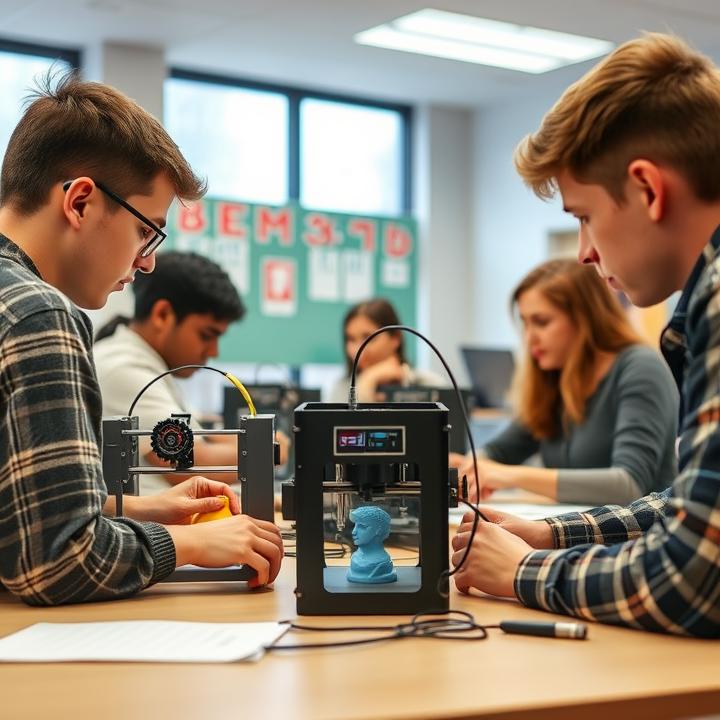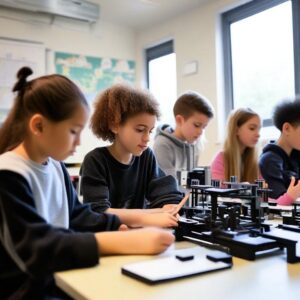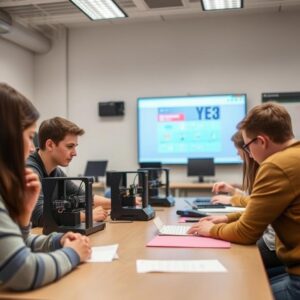How 3D Printing is Transforming Education: Case Studies and Future Possibilities

Discover how 3D printing is reshaping education across various fields. Explore real-world case studies and innovative applications of additive manufacturing in classrooms, museums, and research environments.
The Role of 3D Printing in Education
3D printing, or additive manufacturing, has revolutionized numerous industries, and education is no exception. With the ability to create tangible, interactive models from digital designs, 3D printing is bringing new possibilities for hands-on learning in classrooms, museums, and research labs. Whether it’s creating interactive models for complex concepts, allowing students to design their projects, or helping teachers present information in novel ways, 3D printing is transforming how education is delivered at all levels.
This article delves into how 3D printing is being used to enhance education, highlighting its applications in K-12 schools, universities, museums, and more. We’ll explore significant case studies, discuss the benefits of 3D printing for both students and educators and look at how this technology is shaping the future of learning.
Case Study 1: 3D Printing in K-12 Schools: Enhancing STEM Education
One of the most significant applications of 3D printing in education is in K-12 classrooms, particularly in the areas of STEM (Science, Technology, Engineering, and Mathematics). Many schools have integrated 3D printing into their curriculum to enhance the learning experience by creating interactive, hands-on models that help students understand complex concepts.
A High School’s Integration of 3D Printing in STEM
In a high school in New York City, 3D printing is used to teach a variety of subjects, with a particular focus on STEM education. The school’s engineering class uses 3D printing to bring their design concepts to life. Students learn to use 3D modeling software, create prototypes, and then print them out to test and refine their designs.
Examples of 3D-Printed Models in STEM Learning
- Math: Students use 3D-printed geometric shapes to better understand 3D space and volume. These models allow students to physically interact with the shapes and visualize their properties.
- Science: In biology, students use 3D printing to create models of cells, organs, and molecules. These hands-on models make it easier to understand complex systems and processes.
- Engineering: Students design and print mechanical components, testing them to learn about engineering principles such as tension, compression, and material properties.
Results and Benefits
The use of 3D printing in these classes has resulted in improved student engagement and a deeper understanding of STEM concepts. Students can see their ideas turn into real objects, which reinforces the learning process and gives them a sense of achievement. Moreover, the hands-on nature of 3D printing encourages creativity, teamwork, and problem-solving skills, essential qualities for students pursuing careers in engineering, technology, and science.
Case Study 2: University of Michigan’s Use of 3D Printing for Medical Education
At the University of Michigan, 3D printing is used to enhance medical education by providing medical students with patient-specific models for practice. Rather than learning through diagrams or digital images, students can practice on tangible, accurate models that represent real-world anatomy.
3D-Printed Human Anatomy Models for Medical Students
The University of Michigan’s medical school utilizes 3D printing to create detailed anatomical models based on CT and MRI scans of actual patients. For example, students studying cardiac surgery can use 3D-printed hearts to simulate procedures, practicing techniques on lifelike models before performing them on real patients.
Benefits of 3D-Printed Models in Medical Education
- Hands-on Practice: Students can physically manipulate and examine 3D models of organs, bones, and other anatomical structures, gaining a better understanding of their shapes, sizes, and functions.
- Personalized Learning: Because the models are based on real patient data, students can learn how to address specific medical conditions and surgeries, improving their diagnostic and surgical skills.
- Improved Outcomes: Research shows that 3D printing in medical education results in improved retention of knowledge and better clinical performance. Students can practice complex surgeries on printed models, leading to greater proficiency in real-life scenarios.
Results and Benefits
The use of 3D printing in medical education at the University of Michigan has led to higher levels of confidence among students and better preparation for real-world medical situations. The ability to interact with patient-specific models ensures that students are more prepared to diagnose and treat real patients, ultimately improving the quality of healthcare.
Case Study 3: 3D Printing in Museums: Bringing History and Art to Life
Museums around the world are using 3D printing to create interactive exhibits and replicas of artifacts, making it easier for visitors to engage with history and art. These models allow museum-goers to handle, examine, and even manipulate objects that would otherwise be too fragile or valuable to touch.
The British Museum’s Use of 3D Printing for Cultural Preservation
The British Museum in London has utilized 3D printing to make replicas of its vast collection of ancient artifacts. One particularly notable project involved the creation of a 3D-printed replica of the Parthenon sculptures, which are often too delicate to be displayed or touched by visitors.
Making Artifacts Accessible
Using 3D printing, the museum has been able to create accessible, accurate replicas of these historical pieces. Visitors can examine the models up close and even interact with them in ways that would not be possible with the original artwork.
Results and Benefits
The use of 3D-printed replicas in museums allows for better preservation of valuable historical artifacts while also enhancing the visitor experience. It also enables museums to create educational programs where students and visitors can learn about ancient cultures through hands-on experiences. Furthermore, the replicas can be distributed to schools, making history more accessible to students who may not have the opportunity to visit the museum in person.
The Benefits of 3D Printing in Education
1. Enhanced Learning through Hands-On Models
3D printing enables educators to create tactile, interactive models that engage students more effectively than traditional teaching materials. These models help students visualize complex ideas and understand abstract concepts by interacting with physical objects.
2. Fostering Creativity and Innovation
3D printing encourages creativity by allowing students to design, prototype, and iterate on their ideas. It empowers students to bring their visions to life, fostering problem-solving skills and innovation.
3. Personalized Learning Experiences
With 3D printing, educators can customize learning materials to fit the needs of individual students. For example, medical schools can create patient-specific models for surgical practice, and art teachers can provide students with 3D-printed replicas of famous sculptures for closer inspection.
4. Increased Accessibility
3D printing makes it easier to reproduce rare or fragile objects, such as historical artifacts, and distribute them to students or museum visitors. This accessibility allows for a more inclusive educational experience, where students can interact with materials that would otherwise be out of reach.
5. Improved Collaboration and Communication
3D printing promotes teamwork and collaboration. Students often work together on projects, from designing prototypes to solving technical challenges, which helps them develop communication skills and the ability to collaborate effectively.
The Future of 3D Printing in Education
1. Virtual Reality and Augmented Reality Integration
As technology advances, 3D printing is likely to be integrated with virtual and augmented reality (VR/AR) to create immersive learning experiences. Students could wear AR glasses and view 3D-printed models in real-time, or take virtual field trips to explore complex structures in ways that were previously impossible.
2. Expansion into More Disciplines
While 3D printing has made a significant impact on STEM education, its applications in fields like art, literature, and history are also expanding. Students studying architecture, for instance, can use 3D printing to create scale models of buildings, while history students can print replicas of ancient manuscripts.
3. Global Collaboration and Sharing
3D printing will continue to break down geographical barriers by enabling global collaboration between students, educators, and researchers. With access to 3D printing, schools and universities can share models and prototypes across borders, creating a truly global learning environment.
Frequently Asked Questions (FAQs)
Q1: How is 3D printing used in education?
3D printing is used to create interactive models for STEM education, medical training, art classes, and history lessons, providing hands-on learning experiences.
Q2: What are the benefits of using 3D printing in classrooms?
A: 3D printing enhances learning by allowing students to interact with tangible models, fostering creativity, improving engagement, and facilitating personalized learning.
Q3: Can 3D printing be used in medical education?
A: Yes, 3D printing is used in medical schools to create patient-specific anatomical models for practice, improving surgical skills and understanding of complex medical conditions.
Q4: How does 3D printing help in museums?
Museums use 3D printing to create replicas of fragile or valuable artifacts, allowing visitors to interact with them and explore history in more accessible and hands-on ways.
Q5: What types of models can be created using 3D printing for STEM subjects?
3D printing can create geometric shapes, molecular structures, mechanical components, and biological models, enhancing the learning experience in math, science, and engineering.
Q6: How does 3D printing support creativity in students?
3D printing allows students to design and prototype their own creations, fostering innovation, problem-solving, and creative expression.
Q7: What are the challenges of using 3D printing in education?
Challenges include the cost of 3D printers, the need for specialized software and training, and the time required to integrate 3D printing into curriculums.
Q8: How can 3D printing enhance art education?
3D printing allows students to create sculptures, explore different art forms, and replicate famous artworks, enabling a hands-on approach to learning about art history and techniques.
Q9: Is 3D printing effective for students with learning disabilities?
A: Yes, 3D printing can provide tactile learning tools for students with learning disabilities, making abstract concepts more tangible and accessible.
Q10: What is the future of 3D printing in education?
A: The future of 3D printing in education includes integration with virtual reality, expanded applications across more disciplines, and increased global collaboration through shared 3D models.
Shaping the Future of Education with 3D Printing
The integration of 3D printing in education has already begun to reshape how students learn, offering new opportunities for hands-on, interactive experiences. As technology continues to evolve, it will play an even greater role in helping students explore complex ideas, develop essential skills, and foster creativity. Whether in K-12 schools, universities, or museums, 3D printing has the potential to revolutionize education, making it more engaging, accessible, and effective for students of all ages and backgrounds.






